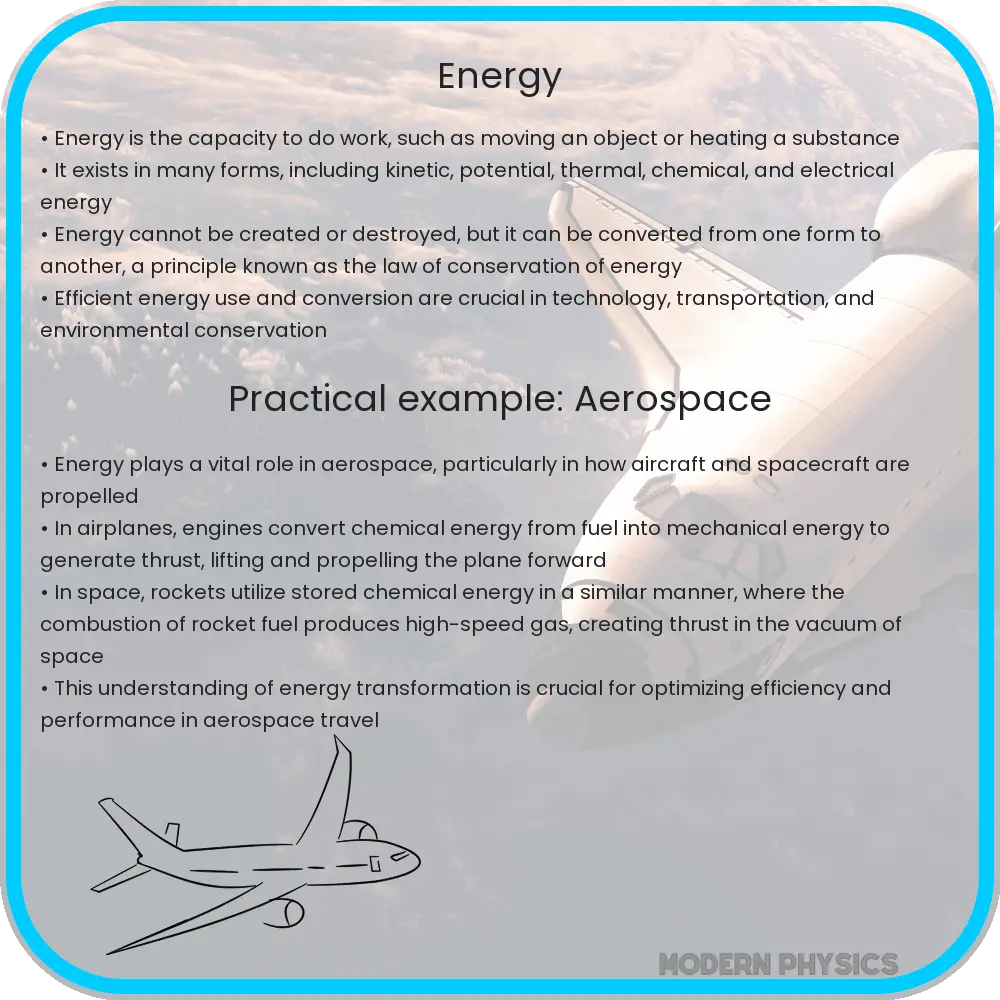Explore the principles of energy in classical mechanics, covering kinetic, potential energy, and conservation laws in real-world applications.

Understanding Energy in Classical Mechanics
Classical mechanics, a fundamental branch of physics, provides a comprehensive understanding of energy and its conservation. Energy, in the context of classical mechanics, is the capacity to do work or produce change. There are various forms of energy, such as kinetic, potential, mechanical, and thermal, each playing a pivotal role in the dynamics of physical systems.
Kinetic and Potential Energy
Kinetic energy, denoted as \( K \), is the energy possessed by an object due to its motion. It is mathematically expressed as \( K = \frac{1}{2}mv^2 \), where \( m \) represents the mass of the object and \( v \) its velocity. On the other hand, potential energy, denoted as \( U \), is the energy stored in an object due to its position or configuration. For instance, gravitational potential energy, a common type in classical mechanics, is given by \( U = mgh \), with \( g \) being the acceleration due to gravity and \( h \) the height above a reference point.
Principle of Conservation of Energy
The principle of conservation of energy states that in a closed system, the total energy remains constant over time. This means that energy can neither be created nor destroyed but can only be transformed from one form to another. In mechanics, this is often seen in the interplay between kinetic and potential energy. For example, in a swinging pendulum, energy continually shifts between kinetic and potential forms, but the total mechanical energy remains constant if we ignore air resistance and friction.
Work and Energy
Work, in physics, is a mechanism through which energy is transferred to or from an object, via the application of a force over a distance. Mathematically, work (\( W \)) done by a constant force (\( F \)) is defined as \( W = Fd \cos\theta \), where \( d \) is the displacement and \( \theta \) is the angle between the force and displacement vectors. The work-energy theorem connects work to the change in kinetic energy, asserting that the work done on an object is equal to the change in its kinetic energy.
Forces and Energy Transformation
Forces play a crucial role in energy transformation in mechanics. For example, a force acting on a body can change its kinetic energy by accelerating it, or change its potential energy by moving it against a field, like gravity or electromagnetism. The nature of these forces—whether conservative or non-conservative—greatly influences the system’s energy transformations and conservation.
In the next section, we will delve deeper into the applications of these principles in real-world scenarios, examining how they underpin the laws of motion and influence the behavior of physical systems.
Applications of Energy Principles in Real World
The principles of energy in classical mechanics have wide-ranging applications in the real world. From the design of roller coasters to the study of planetary motion, these principles guide our understanding of physical phenomena. In roller coasters, for instance, the conversion of potential energy at the highest point into kinetic energy as it descends is a practical demonstration of the conservation of mechanical energy. Similarly, in celestial mechanics, the interplay of kinetic and potential energy explains the orbits of planets and satellites.
Energy in Machines and Devices
Machines and devices leverage the principles of energy to perform work. In a simple lever, for instance, mechanical advantage is gained by converting a small force over a large distance into a large force over a short distance. In electrical motors, electrical energy is converted into mechanical energy, illustrating the versatility and interconvertibility of energy forms.
Non-Conservative Forces and Real-World Complications
In the real world, non-conservative forces like friction and air resistance play significant roles. These forces cause the mechanical energy of systems to decrease over time, as some energy is transformed into thermal energy. Understanding these forces is crucial in engineering, where minimizing energy loss is often a key objective.
Modern Extensions of Classical Energy Concepts
While classical mechanics provides a robust framework for understanding energy, modern physics extends these concepts further. In the realm of quantum mechanics and relativity, energy principles continue to be fundamental but are applied in ways that account for the limitations of classical mechanics at atomic and cosmological scales, respectively.
Conclusion
The study of energy in classical mechanics offers a profound insight into the natural world. From the simple motion of objects to the complex dynamics of astronomical bodies, energy principles provide a unifying framework to understand the universe. The conservation of energy, in particular, serves as a cornerstone principle not just in classical mechanics, but across all domains of physics. As technology advances and our understanding of the universe deepens, the fundamental principles of energy in classical mechanics continue to guide us, reminding us of the elegance and consistency of the physical world.
